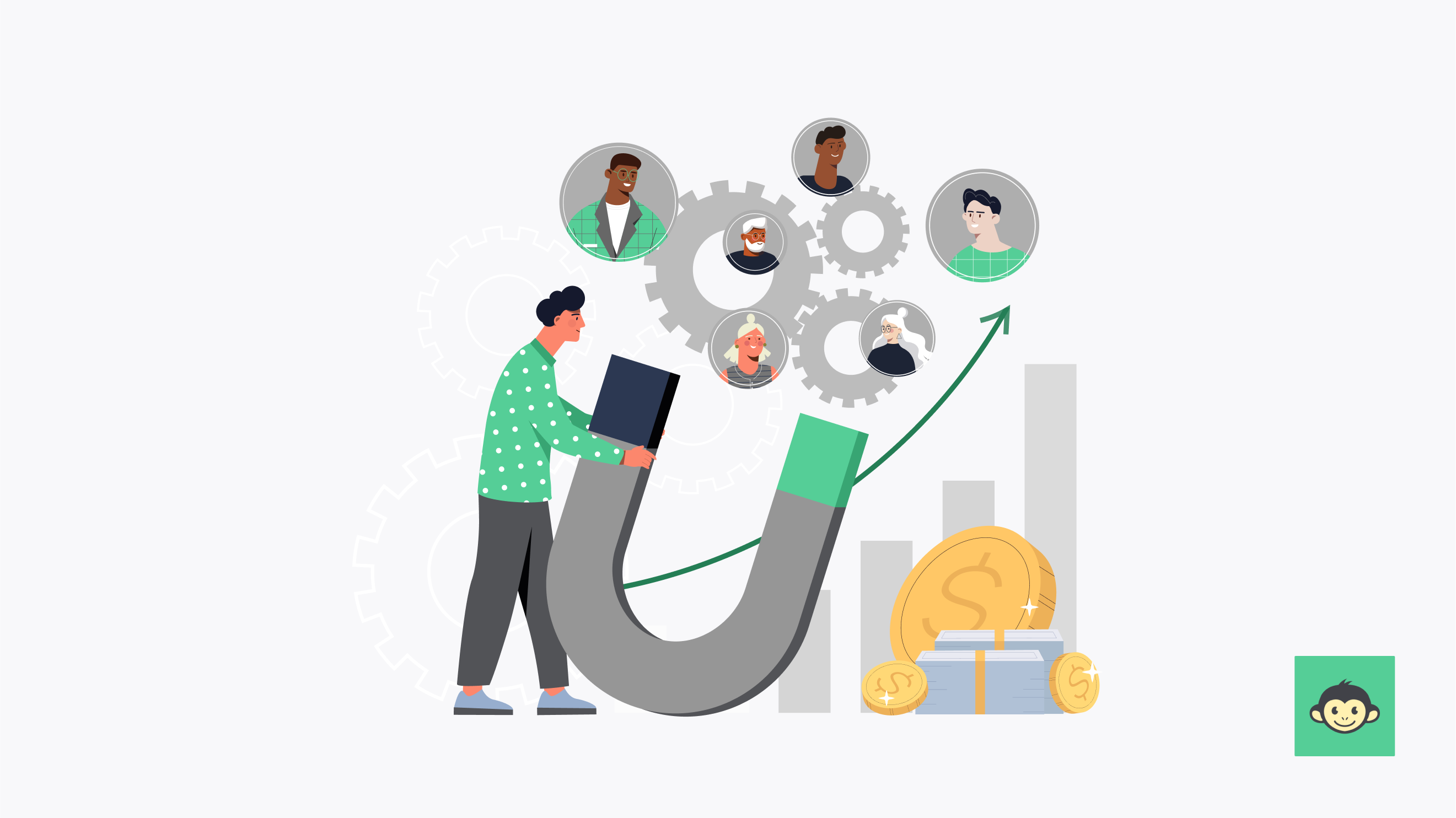35+ Effective employee retention strategies that you should try across industries in 2024

In the wacky world of work, where ping-pong tables and nap pods are no longer enough to keep your top talent from bouncing (or napping) their way out the door, what's an employer to do?
Fear not, weary warriors of retention! Because, let's face it, recruiting is a jungle gym, and keeping your best employees feels like wrangling a pride of particularly independent penguins.
But fret no more because this nifty guide is here to equip you with an arsenal of 35+ super-effective strategies guaranteed to transform your workplace from a revolving door to a sticky flypaper paradise (minus the flies, of course).
We'll delve into everything from the classics, like competitive compensation (because bills gotta get paid), to the downright delightful, like gamified learning programs (because who doesn't love a good challenge with a side of virtual badges?).
So, grab a metaphorical cup of brain juice, settle in, and get ready to discover the secrets to building a workplace where your employees not only stay but thrive (and maybe even do a victory dance, but that's entirely optional).
Why are employees leaving in the new work world?

In the evolving landscape of the new work world, employees are leaving their jobs for several compelling reasons. One primary factor is the pursuit of a better work-life balance. The pandemic-induced remote work trend revealed the feasibility and benefits of flexible schedules, prompting many to seek employers who offer permanent remote or hybrid work options.
This shift has highlighted the inadequacies of traditional office-bound roles, leading employees to leave for positions that better accommodate their personal lives and well-being. Another significant reason is the desire for more meaningful and fulfilling work. As priorities shifted during the pandemic, many workers began to reevaluate their career goals and aspirations.
This introspection has driven a surge in job switches, with employees seeking roles that align more closely with their values, offer greater opportunities for professional growth, and provide a stronger sense of purpose. Companies that fail to provide these elements are finding it challenging to retain talent.
Additionally, the rapid pace of technological advancements and the rise of the gig economy have empowered workers with more options than ever before.
Many employees are exploring freelance opportunities, entrepreneurial ventures, or positions in industries that are better aligned with their skills and interests. This increased mobility and the availability of diverse career paths make it easier for employees to leave unsatisfactory jobs.
Overall, the new work world has reshaped employee expectations and priorities, leading to higher turnover rates as workers seek environments that offer flexibility, fulfillment, and alignment with their personal and professional aspirations.
7 Key benefits of implementing employee retention strategies at work

Implementing effective employee retention strategies to build employee engagement at work offers numerous benefits, enhancing both organizational performance and employee satisfaction. Here are seven key benefits:
1. Reduced turnover costs
High turnover rates are costly due to expenses related to recruiting, hiring, and training new employees. Effective retention strategies and human resource management help reduce these costs by keeping experienced employees within the organization.
2. Increased productivity
Long-term employees are typically more familiar with company processes and systems, which enhances their efficiency and productivity. Retention strategies that focus on employee satisfaction and development help maintain high productivity levels.
3. Improved employee morale
A stable workforce fosters a positive work environment. When employees see that their colleagues are staying in and thriving in their jobs, it boosts overall morale and fosters a sense of community and loyalty within the team.
4. Enhanced company culture
Retention strategies that emphasize employee engagement and satisfaction contribute to a strong, positive company culture. A supportive and inclusive culture attracts and retains top talent, creating a virtuous cycle.
5. Better customer relationships
Employees who stay longer develop deeper relationships with other employees and engage their customers. These strong relationships lead to better customer service and satisfaction, as well as increased customer loyalty and retention.
6. Continuous skill development
Retaining employees allows for ongoing professional development and skill enhancement to retain employees. Organizations can invest in their employees’ growth, leading to a more skilled and capable workforce that can adapt to changing market demands.
7. Higher employee engagement
Strategies focused on increased employee retention will often include initiatives for employee engagement, such as recognition programs, career development opportunities, and feedback mechanisms. Engaged employees are more committed to their work and the company’s success, resulting in better overall performance.
The importance of having in place an employee retention strategy

Having an employee retention strategy in place is crucial for the sustained success and growth of any organization. Firstly, it helps mitigate the high costs associated with employee turnover, including recruitment, training and lost productivity during the transition period.
A well-thought-out retention strategy ensures that the investment in employee development yields long-term benefits as experienced employees stay longer, bringing stability and continuity to the workforce.
Additionally, retention strategies contribute significantly to maintaining a strong culture and high levels of employee morale and engagement. When employees feel valued and see clear opportunities for growth and advancement within the company, they are more likely to be motivated and committed to their roles.
This leads to increased productivity and a positive work environment, which are essential for achieving organizational goals.
Moreover, a robust retention strategy enhances the overall company culture, fostering a sense of loyalty and belonging among employees. This, in turn, helps attract top talent, as a reputation for valuing and retaining valuable employees makes the organization more appealing to prospective candidates.
8 Key drivers of employee retention

Effective employee retention is driven by several key factors that ensure employees remain satisfied and committed to their organizations. Here are eight key drivers of high employee retention rates:
1. Competitive compensation and benefits
Offering competitive salaries, comprehensive benefits packages, and performance bonuses are fundamental to retaining employees. Financial rewards that reflect the market rate and recognize employee contributions help prevent dissatisfaction and turnover.
2. Career development opportunities
Providing clear paths for career advancement and opportunities for professional development is crucial. Employees who see a future within the company and have access to training and skill enhancement are more likely to stay long-term.
3. Positive work environment
A supportive, inclusive, and collaborative work culture fosters loyalty. Employees who feel respected, valued, and part of a cohesive team are less likely to seek opportunities elsewhere.
4. Work-life balance
Offering flexible work arrangements, such as remote work options, flexible hours, and generous leave policies, helps employees manage their personal and professional lives effectively, reducing burnout and increasing employee job satisfaction too.
5. Recognition and reward
Regularly acknowledging and rewarding employees for their hard work and achievements boost morale. Recognition programs, whether through formal awards or informal praise, reinforce employees’ sense of value and accomplishment.
6. Effective leadership
Good leadership is a major retention driver. Managers who are supportive, communicative and provide clear direction help build trust and loyalty among their team members.
7. Engagement and inclusion
Encouraging employee involvement in decision-making processes and fostering a sense of belonging through diversity and inclusion initiatives can significantly enhance retention. Employees are more likely to stay when they feel their voices are heard and valued.
8. Health and wellness programs
Promoting employee well-being through health and wellness programs, mental health support, and a healthy work environment demonstrates the company’s commitment to its employees’ overall well-being, which can increase loyalty and boost employee retention too.
35+ Effective employee retention strategies you can try across industries in 2024

Employees retention strategies for the tech industry
- Competitive compensation and benefits: Offer competitive salaries, stock options, and comprehensive benefits to attract and retain top talent.
- Continuous learning and development: Provide opportunities for employees to learn new skills, gain certifications, and attend industry conferences.
- Flexible work arrangements: Allow remote work, flexible hours, and hybrid work models to accommodate employees' work-life balance.
- Challenging projects: Assign challenging and innovative projects that keep employees engaged and motivated.
- Recognition and rewards: Implement a robust recognition program that acknowledges employees' contributions and achievements.
Employee retention Strategies for Restaurants
- Career advancement opportunities: Offer clear paths for promotion and career growth within the restaurant.
- Competitive pay and tips: Ensure fair wages and equitable tip distribution among staff.
- Work-life balance: Provide flexible scheduling and time-off policies to prevent burnout.
- Positive work environment: Foster a respectful, supportive, and inclusive workplace culture.
- Training and development: Provide comprehensive training programs to improve skills and boost employee confidence.
Employee retention strategies for nursing homes
- Supportive management: Ensure managers provide consistent support, guidance, and feedback to staff.
- Competitive salaries and benefits: Offer attractive compensation packages, including health benefits and retirement plans.
- Professional development: Support ongoing education and certification opportunities for nursing staff.
- Employee wellness programs: Implement programs focusing on physical and mental health to support employees' well-being.
- Safe working conditions: Ensure a safe and healthy working environment with adequate staffing levels to prevent burnout.
Employees retention strategies for nonprofit organizations
- Mission alignment: Ensure employees are aligned with and passionate about the organization's mission and values.
- Transparent leadership: Maintain open and transparent communication between leadership and staff.
- Professional development: Offer training, workshops, and career development opportunities tailored to the nonprofit sector.
- Flexible work policies: Provide flexibility in work hours and locations to support work-life balance.
- Volunteer opportunities: Encourage employees to participate in volunteer activities that align with the organization's goals.
Employees retention strategies for the hospitality industry
- Employee recognition programs: Regularly acknowledge and reward employees for exceptional service and performance.
- Comprehensive training programs: Invest in training to enhance customer service skills and operational efficiency.
- Career pathways: Offer clear career progression opportunities within the organization.
- Competitive compensation: Provide attractive wages and benefits, including health insurance and bonuses.
- Work-life balance: Promote a healthy work-life balance with flexible scheduling and time-off policies.
Employee Retention Strategies for the Banking Sector
- Performance-based bonuses: Offer bonuses and incentives tied to individual and team performance.
- Continuous learning: Provide opportunities for professional growth through training programs and certifications.
- Mentorship programs: Implement mentorship programs to support career development and knowledge sharing.
- Employee engagement initiatives: Conduct regular surveys and feedback sessions to understand and address employee concerns.
- Work-life integration: Offer flexible work arrangements and wellness programs to support employees' overall well-being.
Employee retention strategies for small businesses
- Personalized recognition: Acknowledge individual contributions through personalized awards and recognition.
- Competitive pay and benefits: Ensure salaries and benefits are competitive with larger companies.
- Professional growth: Offer opportunities for skill development and career advancement within the small business context.
- Inclusive culture: Foster an inclusive and supportive workplace where every employee feels valued.
- Employee ownership: Implement profit-sharing or stock ownership plans to give employees a stake in the business.
- Flexible work environment: Allow flexible work hours and remote work options where possible.
- Open communication: Maintain open lines of communication between management and staff to build trust and transparency.
How to implement employee retention strategies the right way: 7 Best practices

Implementing employee retention strategies effectively requires a thoughtful and systematic approach. Here are seven best practices to ensure successful implementation of key retention strategies:
1. Conduct regular employee surveys
Regularly gather feedback from employees through surveys to understand their needs, concerns, and satisfaction levels. Analyze survey data to identify trends and areas for improvement. Share the results with employees and develop action plans to address their feedback effectively.
2. Offer competitive compensation and benefits
Ensure your organization offers competitive salaries and benefits packages within the industry. Conduct regular market research to benchmark your company's benefits package and compensation offerings. Keep your packages updated to attract and retain top talent, and communicate the value of these benefits to your employees.
3. Foster a positive workplace culture
Cultivate a workplace environment that values respect, collaboration, and inclusivity. Encourage open communication and feedback among team members.
Implement diversity, equity, and inclusion initiatives to ensure all employees feel valued and respected. Celebrate employee achievements and milestones to foster a sense of belonging and appreciation.
4. Provide career development opportunities
Invest in your employees' professional growth by offering various opportunities for development. Provide access to training programs, workshops, and mentorship opportunities.
Create clear career progression paths within your organization's ability, and communicate these pathways to employees. Support employees in pursuing further education or certifications relevant to their roles.
5. Enhance work-life balance
Support your employees' well-being by promoting work-life balance initiatives. Offer flexible working arrangements, such as remote work options or flexible hours, to accommodate personal commitments.
Implement wellness programs that focus on physical, mental, and emotional health. Encourage employees to take regular breaks and utilize their vacation time to prevent burnout.
6. Recognize and reward contributions
Establish a comprehensive recognition and rewards program to acknowledge employees' hard work and achievements. Provide timely and specific recognition for individual and team accomplishments.
Offer a variety of rewards, such as bonuses, gift cards, extra time off, or public recognition events encouraging employees. Ensure recognition aligns with company values and reinforces desired behaviors.
7. Ensure effective leadership and management
Invest in developing strong leaders and managers who can support and engage their teams effectively. Provide leadership development programs that focus on communication, empathy, and conflict resolution skills.
Encourage regular one-on-one meetings between managers and their team members to provide feedback and support. Hold managers accountable for their team's engagement and retention rates to create a positive and productive work environment.
How do pulse surveys help you keep track of your employees’ current sentiments in real-time?

Pulse surveys are invaluable tools for staying connected with employees' sentiments in real time. Unlike traditional annual or quarterly surveys, pulse surveys are shorter, more frequent assessments that capture employees' feelings, attitudes, and concerns at specific intervals.
By regularly collecting feedback through pulse surveys, organizations can gain immediate insights into the current state of employee morale, engagement, and satisfaction.
These surveys typically consist of a handful of concise questions designed to gauge employees' opinions on various aspects of their work environment, such as job satisfaction, work-life balance, communication effectiveness, and overall organizational culture.
Because of their brevity and frequency, pulse surveys offer a dynamic snapshot of employee sentiment, allowing organizations to identify emerging issues or trends promptly.
Furthermore, pulse surveys enable organizations to adapt quickly to changing circumstances or challenges. For example, if a sudden change in company policy or external factors impacts employee morale, pulse surveys can help management pinpoint the cause and take swift action to address concerns or implement necessary adjustments.
Significance of employee retention software in helping you with retention at work
Employee retention software plays a crucial role in helping organizations effectively manage and improve employee retention rates. This software offers a comprehensive set of tools and features designed to identify, analyze, and address factors influencing employee turnover.
One significant aspect of employee retention software is its ability to collect and analyze data related to employee engagement, satisfaction, and turnover. By aggregating data from various sources such as surveys, performance reviews, and exit interviews, the software provides valuable insights into the underlying causes of turnover.
These insights enable organizations to identify patterns, trends, and areas for improvement, allowing them to develop targeted retention strategies. Moreover, employee retention software often includes predictive analytics capabilities, allowing organizations to forecast potential turnover and take proactive measures to prevent it.
By leveraging predictive models, organizations can identify at-risk employees and intervene with targeted interventions, such as personalized development plans, mentorship programs, or retention bonuses, to retain top talent.
Conclusion
Employee retention serves as a powerful way for organizations to understand, analyze, and address factors contributing to turnover. By leveraging data-driven insights and predictive analytics, organizations can proactively identify at-risk employees and implement targeted retention strategies.
Furthermore, using employee retention software like CultureMonkey facilitates communication and collaboration, fostering a supportive work environment that enhances employee engagement and satisfaction.
Ultimately, investing in comprehensive employee retention programs and software enables organizations to mitigate turnover risks, improve retention rates, and drive long-term success by retaining top talent.



